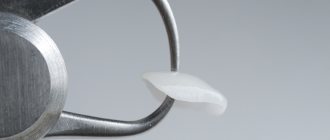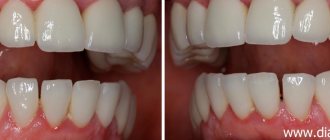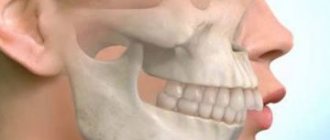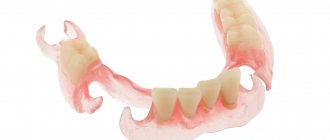Completely removable dentures are used for prosthetics of jaws that are completely devoid of teeth (in the case of edentia). The prosthesis is held on the jaw due to its tight fit to the tissues of the prosthetic bed. If we are talking about a prosthesis for the upper jaw, then high-quality fixation can be achieved through a special valve that creates negative pressure, that is, in essence, the prosthesis is held in place by vacuum. Traditionally, dentures for the lower jaw are very uncomfortable, this is due to poor conditions for their reliable fixation. Specially developed adhesive pastes and creams can help keep the prosthesis in place; they significantly improve the retention (fit) of the structure. Often, such dentures are made of acrylic plastic, with the help of special dyes, it is given the color and shade of the patient’s gums so that it does not stand out against the background of the oral cavity, and artificial teeth are mounted into it, which exactly imitate a person’s normal bite.
The process of getting used to dentures (full or partial) is often long and difficult
Thanks to such products, patients can enjoy life again, eat whatever they want (and even what they could not afford before), since chewing function is completely restored. Without the use of this type of prosthesis, you can forget about normal trips to catering establishments or family feasts, since such a person will not be able to afford anything other than yogurt or puree.
But the question arises - how to get used to dentures ? The process of getting used to removable dentures is very long and often difficult. Such prosthetics cannot be called a complete procedure, since the oral mucosa is constantly irritated, and the patient himself experiences discomfort.
What problems may arise after installing a denture?
Adaptation to a removable denture begins almost immediately after installation is completed in the dentist's office. And, according to statistics, almost every patient experiences certain difficulties that are associated with the adaptation period. Here are some of them:
- Vomiting reflex . Constant vomiting is a completely normal reaction of the body to a foreign object in the oral cavity, so there is no need to worry too much about this. But there is a category of people who take the longest to get used to dentures, or who don’t get used to them at all. The installation of products that stick to the sky is contraindicated for them. This must be taken into account when choosing a prosthetic method. Often, this problem goes away on its own. But for patients with hypersensitivity, it is better to abandon such structures altogether.
- Profuse salivation . The human body perceives the prosthesis as food, as a result of which the brain sends signals that then activate the corresponding functions, namely the secretion of saliva and gastric juice.
- Unpleasant sensations while eating . First of all, this problem affects the owners of removable dentures; the load is unevenly distributed across the jaw, in contrast to the natural chewing of food with real teeth. It takes a long time to get used to this.
- Perception of taste . You may partially lose your sense of taste, since not only the tongue (as many believe), but also the rest of the oral cavity is involved in its perception. The patient may stop feeling spicy, salty, hot or sweet foods; this process occurs differently for everyone.
- Distortion of speech . The prosthesis and its protruding parts can interfere with the tongue; a person with an installed prosthesis has difficulty pronouncing words. But after some time (about a week), diction returns to normal.
Why does discomfort occur?
A person with missing teeth gets used to living without them. His dental system begins to distribute the chewing load differently, and the muscles, cheeks, nerves, tongue and jaw bones involved in the process gradually get used to the restructuring that has occurred.
If missing teeth can be restored with permanent dentures, the parameters of which are almost identical to natural teeth, the load when chewing food turns out to be natural. And the absence of foreign elements - fixing hooks and staples - guarantees the absence of irritation of the mucous membranes of the cheeks and tongue.
In removable structures, the chewing load is distributed differently. For example, popular clasp dentures distribute it to the palate and the remaining adjacent teeth. It is clear that the sensations when chewing food will be unusual at first and will almost certainly cause irritation.
Useful tips for those who have recently installed a prosthesis
Literally from the first days of using a prosthesis, many patients complain of pain, as well as abrasions and scratches in the oral cavity. In fact, mechanical damage should not occur, since this point was thought out at the product design stage. Perhaps you are simply wearing it incorrectly. If the problem does not resolve itself, you need to contact your dentist for further adjustments to the prosthesis.
The tips given below will not completely relieve you of difficulties during the adaptation period, but they will significantly reduce the level of negative impact and will help you get used to the prosthesis faster.
The process of chewing food causes pain, so in the first few weeks it is better to protect yourself from eating solid and tough foods: meat, nuts, cookies, etc. If even soft food is painful to chew, then at first you can cut it into small pieces. Trust your feelings, and when the pain begins to subside, gradually move on to your usual, normal diet.
Under no circumstances should you reduce the number of meals. Most patients, due to a strong fear of getting damage to the oral cavity (and they take a very long time to heal), switch to liquid foods and yoghurts. But this is not the right solution, since in order to get used to the prosthesis, a constant chewing load is needed.
Foods such as pears, apples and citrus fruits should be cut into small pieces and chewed slowly, with great effort. This allows you to reduce the degree of damage to the mucous membrane, and also gives the body all the necessary vitamins.
If you have a dry mouth or increased salivation, it is recommended to drink plenty of liquid in small sips throughout the day.
If you feel slight numbness, you can do a light massage of the gums, this will improve blood circulation and the numbness will go away in just a few minutes. In this case, you need to remove the prosthesis.
Decoctions of herbs such as sage and chamomile will help strengthen your gums and prevent irritation. It is advisable to carry out the procedure three times a day. The decoction should never be hot; liquid at room temperature is the best option.
Useful exercises
To make it easier to get used to the new jaw, dentists recommend helping the body accept the prosthesis. Speech exercises are prescribed. When installing dental structures, speech is impaired. Patients complain that, out of embarrassment to appear stupid, they stop talking, which is not allowed.
Tongue exercises will speed up the habituation. Set aside 60 minutes a day for exercise.
The point is that you need to pronounce the words slowly at first, and then pick up the pace. In addition to individual words, reading books and tongue twisters out loud is suitable. No one promises immediate restoration of speech, but improve your diction in a week.
Accelerate the process of getting used to the prosthesis
- Rinse your mouth with a salt solution;
- Take the process of cleaning your denture seriously;
- Try sucking on lollipops, this process calms you down and distracts you from having a foreign object in your mouth;
- To improve your diction, say tongue twisters, read aloud, and speak more often. It’s also worth trying to pronounce words louder. Often, normal speech is restored within a few weeks;
- For a more reliable fixation of the prosthesis in the oral cavity, it is best to use special gels and ointments; they not only allow you to securely fix the product in the mouth, but also prevent the appearance of abrasion wounds and other mechanical damage to the oral cavity.
- It is necessary to completely exclude various sticky foods from the diet, and not only for the period of getting used to the prosthesis. These can be candies, various chocolate bars with nougat, toffees, etc.), they can not only cause discomfort during chewing, but also damage the structure.
Reasons for the inconvenient placement of the prosthesis
The main reasons for the appearance of severe discomfort while wearing an orthopedic system include the following factors:
- psychological unpreparedness of the patient for dentures,
- incorrectly manufactured design,
- initially inflamed gums, which were not treated,
- poor hygienic care of the structure and the entire oral cavity,
- features of the condition of the temporomandibular joint,
- uneven relief of the alveolar ridge.
What to do if the addiction is seriously delayed?
If, over a fairly long period of time, you cannot get used to the prosthesis (that is, to a foreign body in the mouth), then there may be several logical explanations for this problem:
- Jaw atrophy;
- Individual characteristics of the jaw structure of a particular patient;
- Poor fixation of the structure;
The most difficult thing to get used to is the so-called clasp structures, which are based on fastenings made of metal. In addition to mechanical effects, exposed metal parts can also have chemical effects, reacting with the acidic environment of the oral cavity. It is simply impossible to correct such a product on your own, as it is easily damaged. Therefore, if you have the feeling that such a design is rather poorly and unreliably fixed in your mouth, it is better to go to a specialist. If the mobility of the prosthesis inside the oral cavity is due to jaw atrophy, a special ointment for additional fixation can help you.
What to do if the prosthesis rubs and does not fit well
- use ointments (Solcoseryl, Metrogyl Denta) or sea buckthorn oil. Apply the oil to the gums for a maximum of 20 minutes after eating and cleaning the denture 3-4 times a day,
- It is forbidden to sharpen dentures yourself, after which you can simply throw it away,
- If there is acute and constant pain caused by rubbing of the structure, you should consult a doctor for correction. 2-3 hours before the visit, the denture should be in the mouth so that the reason why the structure is rubbing becomes visible.
If the device is not fastened well, then you should contact your attending physician - an orthopedic dentist. If the correction does not help, you will have to use special fixation creams: Protefix, Corega, Lacalut Dent. Choose the one that suits you - according to taste, consistency, fixation time. Try different options and choose the best one.
Terms of adaptation
For some, the feeling of discomfort passes quite quickly; for others, the adaptation process is inevitably associated with prolonged physical suffering.
Talking about exact dates is quite problematic, because quite a few factors play a role here. For example, the condition of the patient’s gums at the time of installation of the prosthesis. Severely damaged gums will begin to actively rub against the surface of the product, this will cause even greater irritation. In this case, the adaptation process will drag on for several months. The period of adaptation increases significantly when installing clasp dentures; this type of construction has many metal parts that easily damage the soft tissues of the oral cavity.
Psychological state is an important factor in the process of getting used to dentures. A person who experiences stress, is constantly nervous and tries to remove the prosthesis at the first opportunity, himself prolongs the adaptation period, and quite significantly.
If we talk about averages, then for most patients the adaptation period takes approximately two (2) weeks . The reasons listed above can guarantee to increase the period of adaptation to several months.
Relining the prosthesis
Relining – recreating the inner surface of the prosthesis. The one that lies on the mucous membrane.
Indications for relining the prosthesis:
— The prosthesis constantly falls off.
- Food gets stuck under it.
— The mucous membrane is constantly injured, and correction does not help. In this case, the doctor performs a soft relining with elastic materials .
When else does a doctor do a soft reline?
— If exostoses and sharp edges of the socket protrude from the prosthetic bed.
— The patient’s mucous membrane is too hard and dry.
— The jaw has atrophied very strongly or unevenly.
— The patient suffers from chronic mucosal diseases.
- Allergy to plastic or something else.
— Undercuts in the alveolar process.
There are soft and hard relining.
- For soft ones , silicones are used.
- For hard ones - plastic.
— Relocation can be done by a doctor, it’s called clinical .
- Or a dental technician - laboratory .
Why is laboratory relocation better than clinical relocation?
The technician uses hot-curing plastic, while the doctor uses self-hardening plastic. This is what causes all the problems.
- Self-hardening plastic is more fragile and porous.
- It contains more residual monomer.
- It shrinks and becomes deformed when it hardens.
- Food will get clogged into the pores.
- The aesthetics are worse, and in general... the color fastness is low.
There is only one plus: the doctor does the relocation himself , without a technician.
But, there are methods of temporary clinical relocation. When it is necessary to cure chronic denture stomatitis.
For such therapeutic relining, the doctor uses plasticized acrylic masses.
(Fabric conditioners)
It is an elastic mass that is soft to the touch. It does not put pressure on the mucous membrane and promotes its healing.
This material hardens not during a chemical reaction (like plastic), but due to gelation (like agar-agar, jellied meat, in our opinion). It hardens for a long time, so it takes on the desired relief of the prosthesis. And it doesn't rub.
After the stomatitis has healed, the doctor (or better yet, a technician) permanently relines the prosthesis.
Caring for a removable denture
Proper care of the prosthesis is the key to the fastest possible adaptation. For those people who have previously carefully cared for their oral cavity and teeth, the process of caring for a denture will not become something scary and overly intrusive. You just need to learn a few simple rules:
- Rinse your mouth after every meal. It would also be a good idea to rinse the structure itself. Simply remove it from your mouth and rinse thoroughly under running water;
- Every morning, the denture must be cleaned with a brush and a special paste. Each type of prosthesis has its own accessories, which are selected separately. During the cleaning process, special attention should be paid to the inside of the prosthesis, this is where a huge number of different microorganisms accumulate, and food particles also become clogged. Otherwise, they can cause severe gum inflammation.
- Additional disinfection is still necessary. To carry it out, you will need to purchase some additional funds. In most cases, these are ointments or effervescent tablets, into the solution of which the prosthesis is dipped.
Some products for the care of dentures
Read about dental prosthetics in St. Petersburg in the article.
Moscow metro station Zvezdnaya, Danube Avenue, 23
Do you really have to put up with this?
Making dentures is quite a complex job, in some ways even comparable to art. Working in tandem, the orthopedic surgeon and the dental technician put a lot of effort into making an accurate and as comfortable prosthesis as possible. But in most cases, after putting it on and wearing it, it turns out that it needs some adjustment to the patient’s gums.
To regain lost comfort, you need to walk with the installed structure for 3–4 weeks. During this time, you can get used to the initially interfering prosthesis and get rid of the unpleasant sensations. If you simply remove it when discomfort appears, then you will have to describe all the inconveniences experienced in words, and the doctor will not be able to understand what exactly caused them. Do you want the correction to be effective? Be sure to come to your appointment wearing a prosthesis that causes discomfort.
Correction of dentures is carried out within 15–20 minutes. As a rule, it is possible to restore the patient’s comfort in one or two visits to the dental clinic.
Basic Concepts
Plate dentures
Removable structures include plate and clasp dentures.
Plate dentures, in turn, are partial removable and complete removable.
Partial removable laminar dentures are used when one or more teeth are missing.
Complete removable plate dentures are indicated in the absence of teeth in the upper and/or lower jaw.
A partial denture is a partial removable denture consisting of artificial teeth, artificial gums and special fastening elements (hooks, locks).
Why can complications arise after the installation of removable dentures?
- Poor preparation for prosthetics. Before treatment, it is necessary to carry out sanitation of the oral cavity, restoration, and more often, prosthetics of teeth, which will serve as a support for fixing the prosthesis;
- Insufficient oral hygiene. Can lead to inflammation of the gums under the prosthesis, the formation of caries, pulpitis of the teeth that serve as support for the prosthesis;
- Fracture of the prosthesis. As a result of breakage or displacement of parts of the prosthesis, its fixation in the oral cavity is disrupted, discomfort and pain occur when wearing it;
- Inaccurately manufactured prosthesis. The design should be easily fixed and also removed without much effort. There should be no gaps in the oral cavity between the structure and the gum, but the prosthesis should not put pressure or rub soft tissues. In the first case, food debris will accumulate in the gap, in the second, sores will appear on the mucous membrane, and subsequently bedsores;
- Changes in the position of individual teeth and bite, leading to displacement of the prosthesis.
Preventive measures
To prevent a negative reaction after the installation of dentures, you should follow the strict instructions and recommendations of the dentist. It is necessary to maintain oral hygiene to reduce the risk of inflammation.
To do this, the specialist recommends adhering to the following prevention methods:
- Removable structures must be removed at night. Thus, the gums “rest.” This clause does not apply during the first week of installation.
- You should periodically massage your gums. Using your finger will speed up blood flow and relieve tension from soft tissues.
- When brushing your teeth daily to remove plaque, you need to pay attention to the interdental space and tongue. It is necessary to clean out food debris in the cracks, otherwise an inflammatory process will develop over time. A brush with fine soft bristles and a irrigator should be used to prevent stones. Cleaning time is at least 2 minutes.
- When eating food, you need to distribute the load evenly on both sides of the jaw.
- Rinse after every meal. Herbal infusions and purified water can be used.
- Avoid foods such as chewing gum, nuts, crackers, gummy candies, and hard fruits.
- If indicated, complete absence of dentition, bone tissue atrophy or anatomical features of the jaw, use fixing gels, creams, powders.
Following these dental care rules will allow your gums to quickly adapt to the structure. If cracks, breaks, or loose fit of the plates to the gums appear, you should contact a professional.










